
6th November 2022 Closest known black hole discovered The discovery of Gaia BH1, a binary system containing what is likely the closest known black hole to Earth, is reported by astronomers in the U.S.
Two years ago, astronomers reported a black hole candidate in HR 6819, a system located 1,120 light years from Earth. If confirmed, it would have been the closest known black hole. They later ruled out that particular discovery, which proved to be simply a binary system consisting of two mainstream stars, with no black hole at all. However, another object in a different system has now been identified and described as "unambiguously" a stellar-mass black hole, lying 1,560 light years away. That is half the distance of the current record holder. The system, Gaia BH1, contains a G-type star that is remarkably similar to our own Sun, with 99% of its radius and 93% of its mass. The black hole is estimated at 9.62 solar masses, with a Schwarzschild radius of 28 km (17.4 mi). They orbit around each other in a period of 185 days, with a semi-major axis of 1.4 AU. "Take the Solar System, put a black hole where the Sun is, and the Sun where the Earth is, and you get this system," said Kareem El-Badry, astrophysicist at the Harvard–Smithsonian Center for Astrophysics, and lead author of a new study describing the discovery. "While there have been many claimed detections of systems like this, almost all these discoveries have subsequently been refuted. This is the first unambiguous detection of a Sun-like star in a wide orbit around a stellar-mass black hole in our galaxy."
The object found in Gaia BH1 is also the first "dormant" stellar-mass black hole found in our cosmic backyard. Our galaxy, the Milky Way, contains an estimated 100 million stellar-mass black holes (generally between five and 100 times the mass of our Sun). Only a handful have been confirmed to date, however, and nearly all of these are "active" – meaning they shine brightly in X-rays as they consume material from a nearby stellar companion, unlike dormant black holes which do not. "I've been searching for dormant black holes for the last four years, using a wide range of datasets and methods," explained El-Badry, who gained his PhD in astrophysics last year. "My previous attempts, as well as those of others, turned up a menagerie of binary systems that masquerade as black holes, but this is the first time the search has borne fruit." His team used the 8.1-metre (26.6 ft) Gemini North telescope in Hawaii, currently among the world's most advanced optical/infrared telescopes, which sits atop the 4,200-metre-high (13,800 ft) Mauna Kea. This location provides excellent viewing, due to the superb atmospheric conditions. The new discovery was made possible by exquisite observations of the companion star's motions.
"When we had the first indications that the system contained a black hole, we only had one week before the two objects were at the closest separation in their orbits. Measurements at this point are essential to make accurate mass estimates in a binary system," said El-Badry. "Gemini's ability to provide observations on a short timescale was critical to the project's success. If we'd missed that narrow window, we would have had to wait another year." Gaia BH1 indicates that there could be important gaps in our understanding of how black holes form and evolve in binary systems, and also suggests the existence of an as-yet-unexplored population of dormant black holes in binaries. "It is interesting that this system is not easily accommodated by standard binary evolution models," concluded El-Badry. "It poses many questions about how this binary system was formed, as well as how many of these dormant black holes there are out there." "As part of a network of space- and ground-based observatories, Gemini North has not only provided strong evidence for the nearest black hole to date but also the first pristine black hole system, uncluttered by the usual hot gas interacting with the black hole," said Martin Still, Gemini Program Officer. "While this potentially augurs future discoveries of the predicted dormant black hole population in our galaxy, the observations also leave a mystery to be solved – despite a shared history with its exotic neighbour, why is the companion star in this binary system so normal?" Future telescopes – of which many are planned – may provide answers to these questions. Some of the next-generation observatories being built and deployed in the coming years will include the Thirty Metre Telescope (2024), the European ATHENA X-ray observatory (2028), the Laser Interferometer Space Antenna (2034) and the Einstein Telescope (2035).
Comments »
If you enjoyed this article, please consider sharing it:
|








